GW: Future Siren
Third-Person Shooter, Mystery, Action, Choice Matter
Overall View
Because my writing style leans toward story and narrative-rich, I need to show my ability that deeply aligns with those themes. So, I made branching storytelling, which focuses more on fast-paced combat gameplay. I also make it as another perspective of someone who experiences some effects of Taksa Semesta (monsters universe) fusing with human universe (earth), as the first time the fusion began in Black Puddle.
It started with a thought, ‘How if I make a continuation story of Black Puddle, but it happens to different people at different times and gives different effects because the person is a descendant of someone who made packs with Taksa Semesta’s monsters? So, at a point of the story, the Black Puddle and Future Siren combined into a two-player game and they played as both of the protagonists?’
I know I can jump right to where the protagonists meet. But, what I learned from analyzing AAA games is that one of the reasons why players deeply engage with the game is because they emphasize the player’s character, so it’s necessary to show them the backstory and give them motivations to play the game. That’s why I decided to make it Intro to Act 1 which focuses more on those aspects.
To push myself out of my comfort zone, I also make the story progress through different places, have a branching outcome that causes an NPC to die or stay alive, and accommodate this branching system to affect the story and combat progression.
Worldbuilding: Taksa Semesta
I want to make two universes: human and monster. For the human universe, I used a familiar setting for the crime-mystery detective genre, which takes place in an American/European country and uses English as its main language. That means the monster universe should be distinguishable from those concepts. Then, I remember, I’m Indonesian. Indonesia has TONS of differences with those countries.
I also have adequate resources and the capability to adapt Indonesia-related data into story ideas while lowering the risk of misinterpretation or disrespect caused by a language barrier. So, it’s decided, the monsters universe will take inspiration from Indonesian-related data.
To make the story understandable for the player, I decided to use a more general theme for the bigger picture for this monster's universe: the dark side of humanity. I did this to make sure everything has a deeper meaning, which later can be used to expand the story.
After some research, I decided to subtly show the monsters characteristics through the name of the monsters universe itself: Taksa Semesta.
Taksa = mempunyai makna lebih dari satu (Bahasa Indonesia), which translates to it has more than one meaning.
Semesta = sinonim dari alam/dunia (Bahasa Indonesia), which translates to synonym of nature/universe.
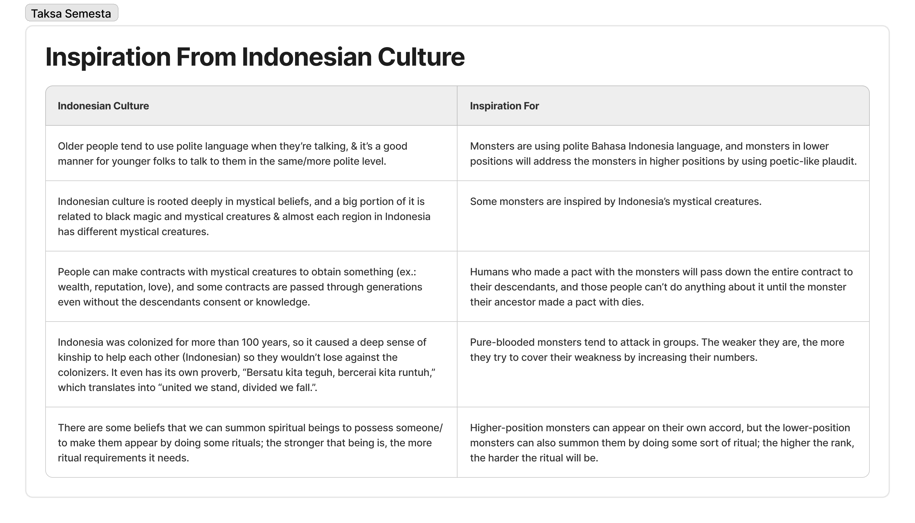

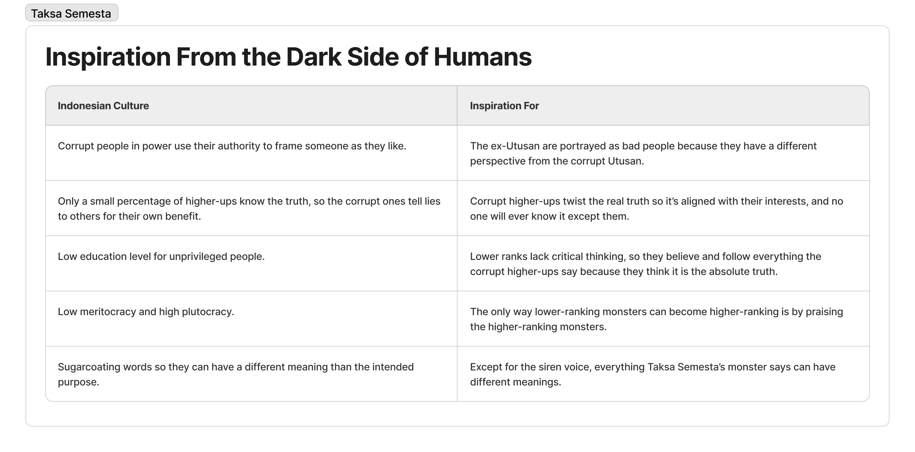

Inspiration From Musics
Beside brainstorming, I did tons of research to make the story have a deeper meaning than what only appears on the surface. I notice the morality conflict that becomes the fundamental in this universe is fitting with the concept of 7 deadly sins and 7 heavenly virtues, so further improvement can be done as long as it follows those categories. I also found some good music that greatly inspired me:

.Feast - Gugatan Rakyat Semesta
Inspiration for: the start of revolution from the kind monsters by collaborating with humans to kill the corrupted monster leader and it's undelings because of their immoral nature.

Alan Wake 2 OST - Ahti - Yötön Yö
Inspiration for: humans have intelligence and emotion, which makes them better beings than the pure-blooded Taksa Semesta monsters, that's why they're getting stronger when they eat humans.

Unlike Pluto - Oh Raven
Inspiration for: the butterfly effect from people in the past who eradicated the descendant of humans who made packs with Taksa Semesta monsters. It becomes an irony when, in the present time, the remaining descendant must save the lineage of the people who killed their ancestors.

Lathi ~ Weird Genius ft. Sara Fajira
Inspiration for: only the descendants of humans who made packs with Taksa Semesta monsters understand the meaning of the monster's plaudit, while normal humans can only hear it but don't understand the meaning.

Nathan Wagner - Paranoia
Inspiration for: weak mental state from becoming an owner of Taksa Semesta’s object, and when the descendants of humans who made packs with Taksa Semesta monsters awakened their powers.
Taksa Semesta Backstories


First of all, I must establish the history to give the bigger picture about the monsters tendencies and how they impact their civilization. Mostly, the inspirations came from different ideologies, where the core difference is their moral compass, which continues to have the polar opposite approach to ideas, problem solving, and everything else. I was also inspired by some political concepts about power tendencies and the conflict elevation between two different parties.
I continue to design the next bigger picture: the conflict between The Earth and Taksa Semesta. Taksa Semesta’s monsters know about this history since they have a long lifespan, but it’s a long-forgotten history for humans. So, when the monsters invade the earth for the second time in this story, the player as the protagonist doesn’t know anything about it, and it becomes one of the main missions in the main game: uncover the history and finds out why it was hidden from modern human civilization.


Since humans who made packs with kind intelligent monsters play a big part in the storyline, I detailed the explanation from both perspectives. They share similar goals and were in the same dire positions, that's why they made pack- which turns out to be successful.
From the monsters perspective, the contract is very advantageous for them since they can achieve their goals by only giving half of their power to the humans, and these pacts were passed down to the human’s descendants, it’s hitting two birds with one stone.


On the other side, humans were on the disadvantage side of the contract. They did get immersive powers, but the prices were too heavy and permanent, which were not suitable for the long run. But, since it's their only way to survive, they didn't have any choice.


The helpful traits of having each other’s backs vanished when the monsters left the earth, and they're replaced by the arrogance and terrible nature of humans. The normal human got blinded by fear and eradicated the collaborators descendant, but this action bit them back in the long run.


Then, to make it easier to understand, I made a flowchart of how intelligence monsters are born.
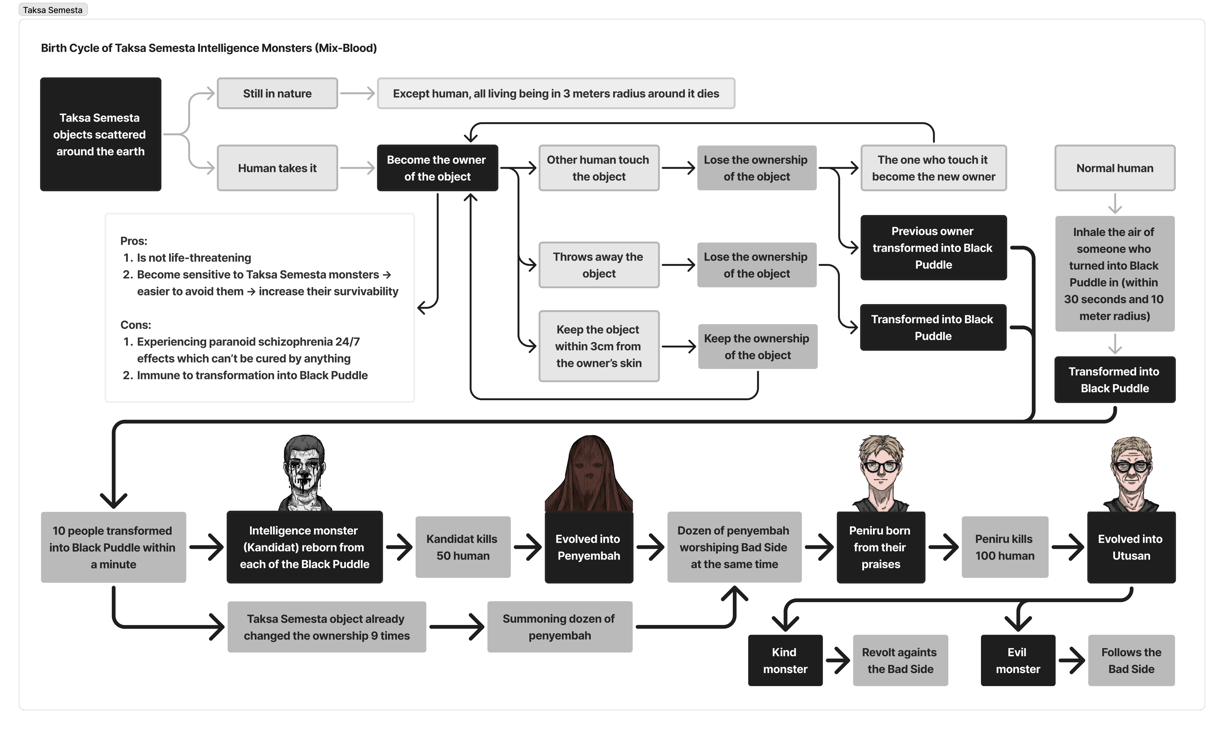

Black Puddle is a pitch-black liquid with tar-like characteristics, but it has a pungent and horrendous smell that is different for each person who smells it.
Taksa Semesta Monsters
There are two kinds of monsters: monsters that are made by the Good Side and Bad Side (pure-blooded) and intelligence monsters which reborn from humans (mixed-blood). The intelligence monsters are inspired by Indonesian cultures and have human-like features. The visual can be changed as long as it’s following the character’s design intention.
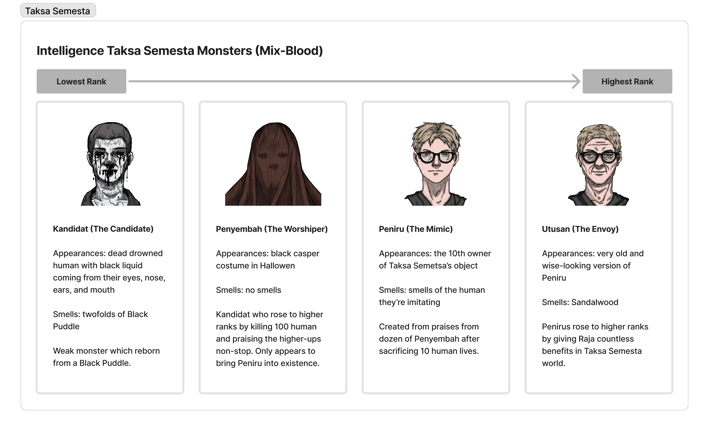

Mix-Blood Monsters
While the names and smells are inspired by Indonesia-related things, While the names and smells are inspired by Indonesia-related things, intelligence monster appearances are the representation of rebirth stages of humans to become more wise: when they died → buried underground → reborn in their prime age → become older and wiser.
Kandidat is inspired by Indonesian folklore named Joko Bodo, where the protagonist drowns his mom and himself to death because of his lack of knowledge, so it has characteristics of a dead, drowned human.
Penyembah is inspired by an Indonesian mystical creature named Pocong. It’s a ghost of someone who died with regret and haunted a certain place using their burial state— body wrapped in a white fabric (kain kafan) and bound at its head, feet, and neck.
Peniru is inspired by an Indonesian belief named Jin Qorin. In short, it’s a doppleganger of someone who’s still alive, but they live in the supernatural world, which often intertwines with the human world.
Utusan is inspired by Indonesian traditional social hierarchy, where the older you are, the more people will respect you because you have more life experiences. This tradition caused the opinions of the elders to be listened to more than those of the younger ones.
Player & Human NPC Concept
Player Name: Chiara Abate
Age: 32 years old
Chiara is a top-tier police captain who's well-known for solving an unsolvable cold case. She is smart, strategic, reliable, and supportive to her team members. But she tends to overthink and freeze under overwhelming pressure, causing her to be prone to doing hasty things and needing others to calm her down.
She's loyal, always makes sure no one is left behind, and tries to keep everyone aligned, causing her to be a very inspiring leader for her subordinates.
Being a captain trains her observation and problem-solving skills that focus on efficiency, so people depend on her to make fast and calculated decisions.
She takes her job very seriously and always stays professional around people she doesn't know that well, but she'll loosen up more to people she knows.
She's protective of her people and will go miles for them, and it also causes her to become more emotionally triggered if something happens to them.
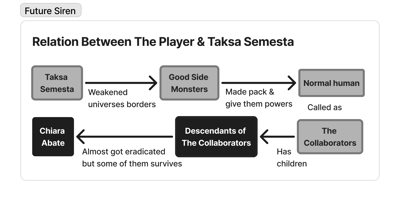

Vice-captain: Clement D’Andrea
Age: 34 years old
Personality: straightforward, cold, but thoughtful
Clement is an introverted type of guy who is ignorant and cold to people he’s not close with, but he’s attentive and sensitive to people he considers important. He’s sarcastic but knows how to read the room. Very smart but doesn’t show because it’s troublesome.
Normal officer: Dante Fedele
Age: 29 years old
Personality: smart, funny, fast thinker
Dante is a muscular guy with a fast reaction response and a quick thinker; he’s not the routine and organized type of guy. He’s a social butterfly and likes to lighten the room using jokes. Has a tendency to be manipulated and become a people-pleaser
New officer 1: Aldo Leone
Age: 24 years old
Personality: analytical, loyal, self-centered
Aldo is a stiff and deep-thinking person, so he likes to analyze everything; his cold and straightforward approach often makes people feel uncomfortable. He’s getting ahead of himself a lot and tends to be self-centered. But he’s very loyal and helpful.
New officer 2: Remo Napoli
Age: 25 years old
Personality: clown in the circus, kind, talkative
Remo is not the smartest person in the room, but he’s the kindest one. A little bit slow in terms of analytical thinking but has high social skills, his warm and friendly personality makes him a fun person to be around but unreliable.
Local policeman: Gilbert Santucci
Age: 35 years old
Personality: considerate, responsible, polite
Gilbert is a diplomatic and hard-working guy; he understands hierarchy and knows how to position himself when facing different people. Sometimes he becomes indecisive, so he’s more of a follower and not someone who can make strategic decisions.
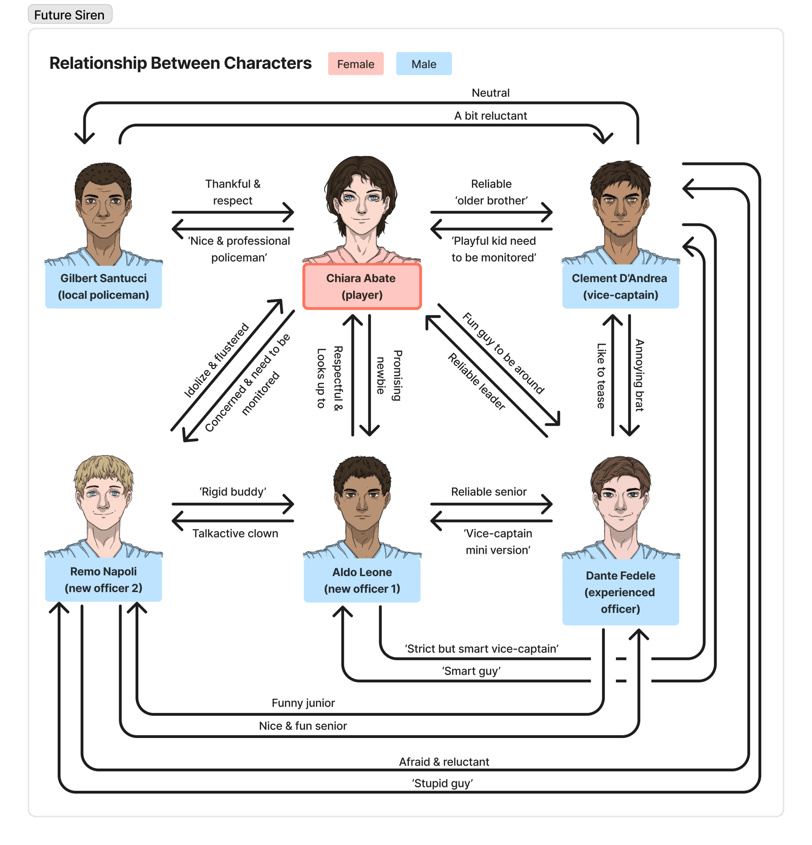

Story Progression
Since it'll become the Intro to Act 1, beside introducing the player's character and the backstory, it will focus to introduce the branching story with fast-paced combat gameplay. Fun and different narrative experiences will become the final target of the story, so seamless transition between different branching route while maintaining the tension become a crucial aspect.
Areas Scope
Since the story is an Intro to Act 1, and my previous project named Black Puddle happened entirely inside a building, I decided to make this story happens on exterior setting, specifically: a small seashore city. I will also incorporate bits of nature areas before entering the city so it doesn't feels boring.
Mission Flow Version 1
After some analysis, I realized the core gameplay in this phase is combat. So, I was thinking, “Even if it’s a branching story, the mission will be the same— killing monsters. So, I only need to make one mission flow but write it in different environments to show the differences between each route.”
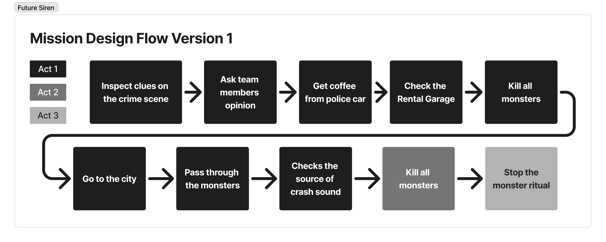

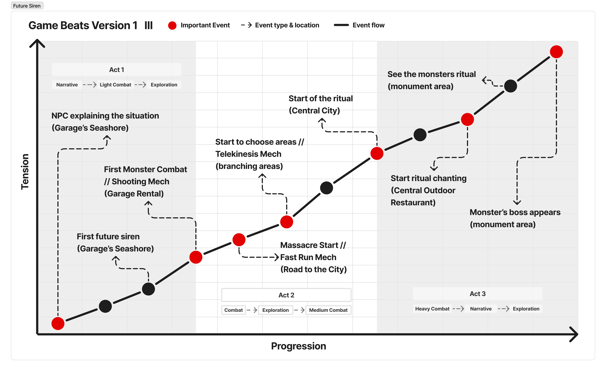

The story was designed to focus on the branching aspects, so there is no flashback scene that diverts the player's attention from the present day. And, because it has combat gameplay, the tension is rising bit by bit to prevent the imbalance between the story, narrative, & combative experience. This way, the player can fully enjoy the game without being rushed.
Game Beats Version 1
Based on those two concepts, I continued to make the first script. But after making it, I realized I was wrong. The same mission flow leads to a monotonous story, it doesn’t feel like branching at all. Each of the route need to be fundamentally different in term of what the player will find there, what kind of monster they’ll be facing, the combat difficulty, etc.
To solve the problems from the first iteration, I did a lot of brainstorming and tried to analyze the different kinds of players that lead to different kinds of gameplay, then incorporated that information into this new iteration. The mission flow was heavily affected by it, while the game beats only underwent some minor changes.
I refined the concepts repeatedly to make sure the branching story really affected the gameplay while keeping the intended story flow intact. Then, it continued to make the new script.
Mission Flow Version 2
Beside making new missions, I also made each branching route have a different gameplay style:
Main Road route = self-investigation & more focus on narrative
Musical Podium route = balanced combat & narrative
Path to The Central City route = speedrun & the hardest fight against the monsters
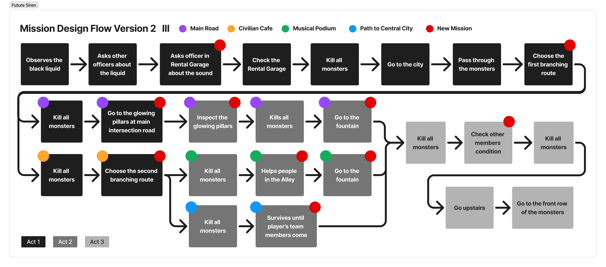

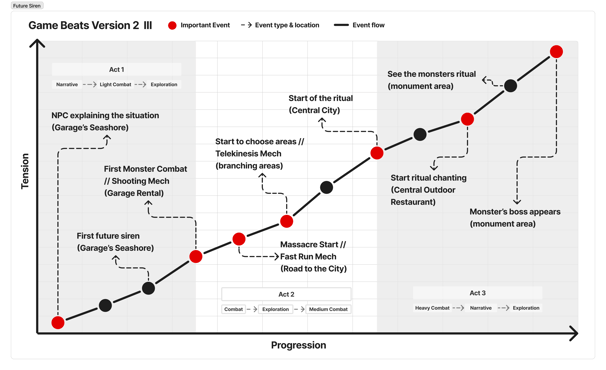

The massive changes in the branching route don't affect the story flow that much since it only changed where some of the events happened. So, in terms of story and narrative, the majority of the changes happened in the script.
Game Beats Version 2
Script & Barks
These are some brainstorming that I made while making the script. Pardon the unrelated scribbles on the sketches, as I made them in my collective gamedev sketchbook.
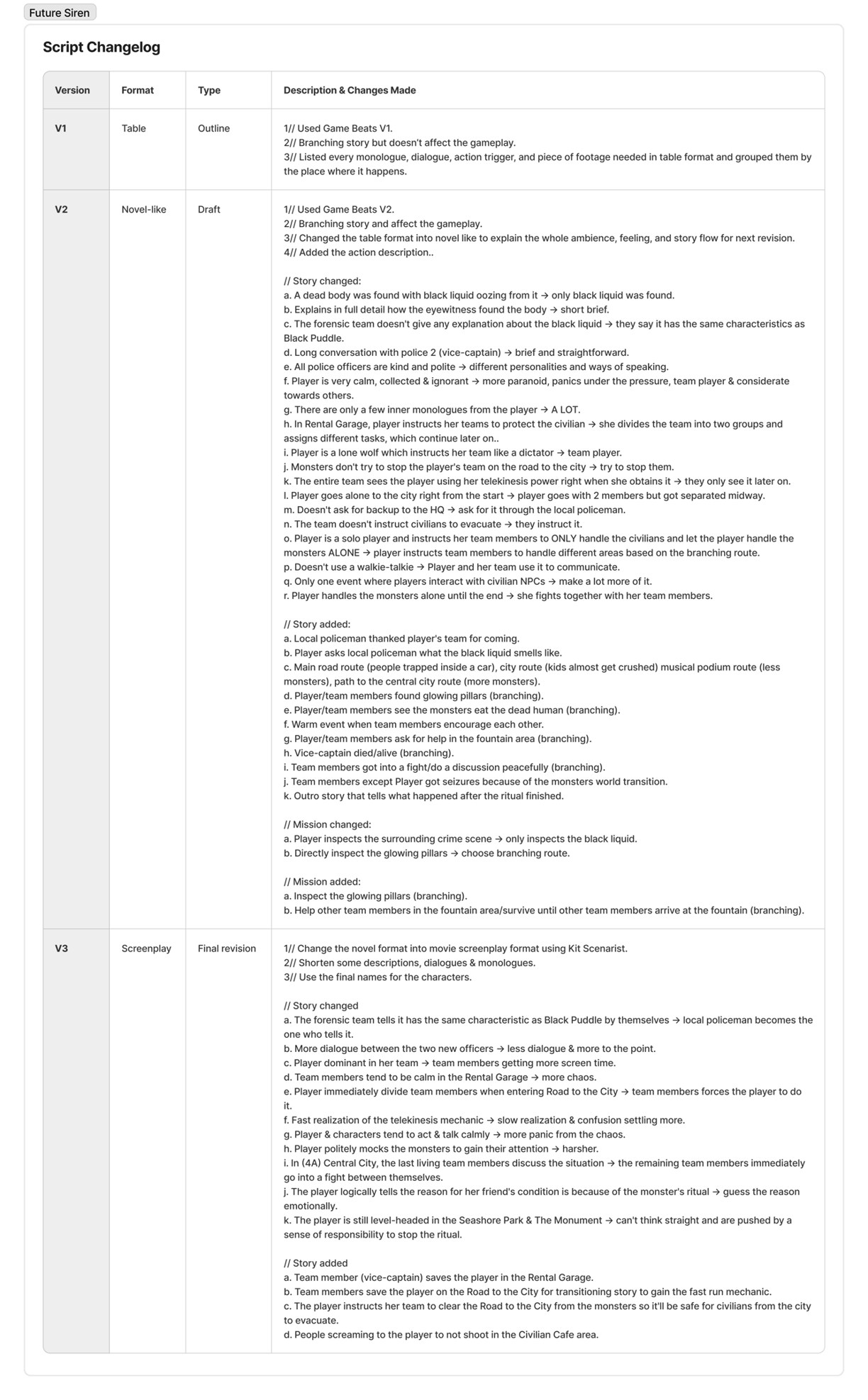

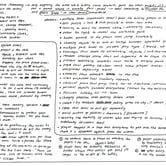
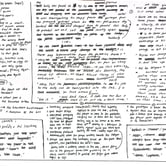
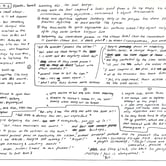
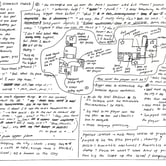
Things I’ve Learned
One worldbuilding can be explored and deepened between different games. To make sure the second game doesn't feel repetitive, approach it through different perspectives and delve into things that haven't been explored in the first game.
Branching story = different experience between each route. If they teach the same gameplay mechanic, make sure each story and narrative feels memorable. Making different kinds of exploration discoveries also helps a ton.
Branching gameplay can explode the number of exploration areas. Make sure to discuss it with other team members (if you're not working solo) because the area's coverage will be affected by their skill sets and other real-life restraints.
The butterfly effect becomes an important aspect in branching stories. By combining them with the crime and punishment concept, the player will be more emotionally engaged as they feel the effects of their choices headfirst.
Psychological aspects that affect a player's decision-making can be intensified through roller-coaster pacing, short time limits when it's decision time, morally grey choices, etc. Mix them differently to keep everything interesting.
Make sure each route follows the key events and tension levels inside the game beats so it’ll be easier to track down, communicate between teams, and won’t confuse the players when they play it again and choose different routes.
